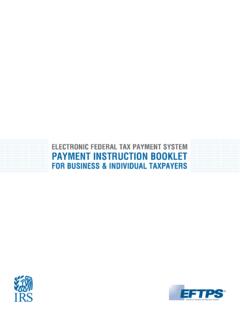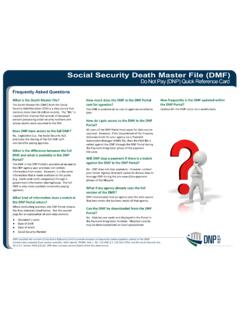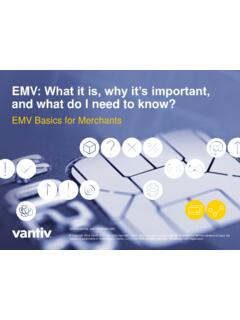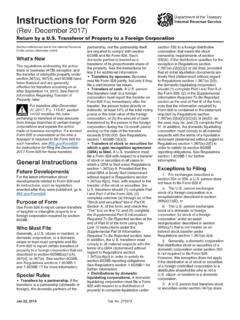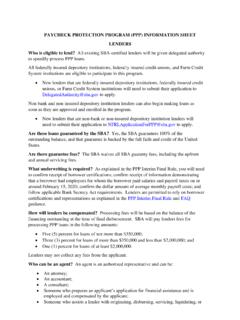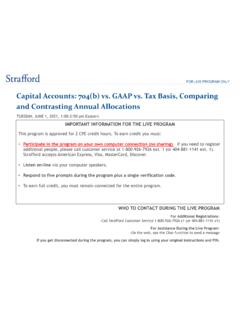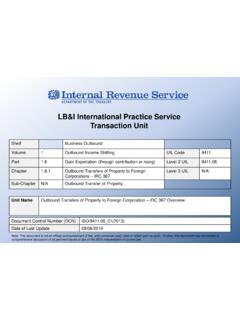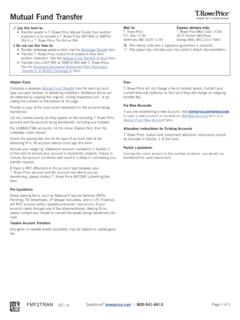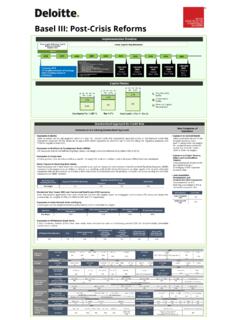Transcription of MANUAL OF PROCEDURES AND INSTRUCTIONS FOR CASHIERS
1 MANUAL of PROCEDURES and INSTRUCTIONS for CASHIERS (Cashier s MANUAL ) Department of the Treasury Financial Management Service April 2001 TABLE OF CONTENTS I. Purpose of Reason for the Update .. Revision of 1 TFM, Part 4-3000 .. II. Authority to Disburse Public III. The Role of the Approving Official .. Who is the Approving Official?.. Appointing CASHIERS .. Determining Cash Reporting Losses .. IV. The Role of the What is a Cashier?.. Types and General Responsibilities Class A Class B Class D Foreign Establishing an Imprest Maintaining an Imprest Advancing Cash for Replenishing the Check Cashing Accountability Cashier Reporting Requesting 1 1 1 2 2 3 3 3 3 4 4 4 4 4 4 5 5 5 5 6 7 8 8 8 9 Transferring Cash to a New Principle 10 Imprest Fund Accounts Held at Financial 10 Liquidating an Imprest 11 Year End 11 V. The Roles of the Alternate Cashier and 12 Alternate 12 12 VI. Internal Controls and Fund 13 Separation of 13 Spot 14 Securing Cash at an Agency 14 Contact 15 16 16 Forms 18 I.
2 INTRODUCTION PURPOSE This updated CASHIERS MANUAL is intended to be used by CASHIERS --and officials designated to appoint CASHIERS (approving officials )--seeking procedural guidance for operating imprest funds. Federal agencies should issue internal policies and PROCEDURES consistent with the principles of this guide and Government Accounting Office Standards governing internal controls for the safekeeping of assets, including separation of duties, monitoring and other activities. The MANUAL is effective for imprest funds which are allowed to operate until October 1, 2001 when Federal agencies are required to eliminate imprest funds in accordance with the Imprest Fund Policy Directive, issued on the imprest fund website at , on November 9, 1999. The MANUAL will remain effective beyond that time for all imprest funds which operate under a waiver from the requirements of the Policy Directive. REASONS FOR THE UPDATE The Federal government is increasingly relying on electronic payment mechanisms to streamline the payment process and reduce administrative and transaction costs.
3 Legislation requiring the Federal government to make payments electronically has spurred the use of electronic alternatives to cash, particularly government purchase cards and, increasingly, debit cards, to eliminate cash payments from imprest funds. Many forms of payments historically made by cash have been converted to Direct Deposit to an individual s bank account, including travel advances and travel reimbursement. This changing payment environment has resulted in the formulation of new policy requiring, with some exceptions, that agencies eliminate their imprest funds. On November 9, 1999, the Financial Management Service published the Imprest Fund Policy Directive (Policy Directive) and other supporting documentation on the Internet at The Policy Directive requires that all Federal agencies eliminate agency use of imprest funds by October 1, 2001, except where waived. The Policy Directive was issued based on the recommendations of the National Performance Review, Report on the Elimination of Imprest Funds in the Federal Government Through the Use of Electronic Commerce, January 1996 (Report), as well as the requirements of the Debt Collection Improvement Act of 1996, and the implementing regulation at 31 CFR Part 208, Management of Federal Agency Disbursements; Final Rule(Treasury EFT Rule).
4 The National Performance Review Report concluded that due to advances in electronic technology, most imprest funds in the Federal Government could be closed and in doing so would save the government millions of dollars in operating costs by increasing Cashier's MANUAL - Page 1 operational efficiency and reducing the amount of funds held outside the Treasury. The Report concluded that it is feasible and appropriate for Federal government agencies to replace their imprest funds with a form of electronic funds transfer (EFT) or third party drafts. Shortly after the Report was issued, Congress passed the Debt Collection Improvement Act of 1996 (DCIA), which requires that, subject to the authority of the Secretary of the Treasury to grant waivers, most Federal payments made after January 1, 1999, be made by EFT. In 1998, the Financial Management Service implemented the provisions of the DCIA by publishing the Treasury EFT Rule. In accordance with the Presidential Memorandum on Plain Language issued June 1, 1998, the CASHIERS MANUAL has been rewritten and reorganized in order to make it easier to reference.
5 REVISION OF 1 TFM, PART 4-3000 This CASHIERS MANUAL contains procedural guidance on the operation of imprest funds, including guidance once contained in the Treasury Financial MANUAL (TFM), I TFM Part 4, Chapter 3000, Imprest Fund Cash Held at Personal Risk by Disbursing Officers and CASHIERS . The MANUAL has been updated to reflect other changes that have taken place since the MANUAL was last updated in June 1993. For example, the old MANUAL makes reference to the submission of payment vouchers using optical character readers. This technology is no longer used by Treasury and reference to it has been deleted. II. AUTHORITY TO DISBURSE PUBLIC MONEY Imprest fund CASHIERS are allowed to disburse public money under the authority of 31 3321, Disbursing Authority in the Executive Branch, which provides that ..only officers and employees of the Department of the Treasury designated by the Secretary of the Treasury as disbursing officials may disburse public money available for expenditure by an executive agency.
6 For reasons of economy and efficiency, it was also provided that - The Secretary [of the Treasury] may delegate the authority to disburse public money to officers and employees of other executive agencies. Treasury s Chief Disbursing Officer has delegated the authority to disburse public money to Federal agency heads or their designees, for purposes of imprest fund management. Cashier's MANUAL - Page 2 III. THE ROLE OF THE APPROVING OFFICIAL WHO IS THE APPROVING OFFICIAL? All agency heads or designees have the authority to delegate cashier appointment and revocation responsibility to an individually named approving official within the agency without the approval of the Financial Management Service (FMS). These individuals are typically fianance or accounting officials. HOW ARE APPROVING OFFICIALS SELECTED? Approving officials are selected by Federal agency heads or their designees by completing FMS Form 2958, Delegation of Authority. Approving officials are not permitted to redelegate their authority.
7 FMS recommends that Federal agency heads and their designees be guided by the Federal Managers' Financial Integrity Act (FMFIA) when designating approving officials. FMS reserves the right to review delegations periodically and reserves the right to revoke this authority if it is deemed that there is any misuse or abuse by Federal agency approving officials APPOINTING CASHIERS HOW DO I APPOINT A CASHIER? As an approving official, you appoint a cashier by completing OF 211, Request for Change or Establishment of Imprest Fund (Request for Change form), or a comparable agency approved form. CASHIERS must be employees of your agency. The Request for Change form no longer requires the signature of the servicing FMS Regional Financial Center. DETERMINING CASH REQUIREMENTS HOW DOES AN APPROVING OFFICIAL DETERMINE CASH REQUIREMENTS? As an approving official, you should review cash requirements based on actual usage at least every 6 months. The review may consist of analysis of the types of payments the fund is used for and the frequency of those payments.
8 A cash review may reveal, for example, that because of a reduction in a certain type of cash payment, the funds are disbursed for that payment less often, which may indicate a need to reduce the fund balance. Analysis of cash requirements should also consider to what extent cash payments may be converted to EFT. Cashier's MANUAL - Page 3 REPORTING LOSSES HOW DO I REPORT A LOSS As an approving official, you should submit a written report to the finance office detailing your knowledge of any reportable loss after you receive a copy of the cashier s report indicating the loss. Depending on the amount of the loss, the agency inspector general s office should also be notified of the loss. See Section IV, Role of the Cashier for more information about requesting relief from liability for losses. HOW DO I ACCOUNT FOR LOSSES You should remove losses from the "Cash Held Outside Treasury" appropriation account and charge any losses to the Federal agency general appropriation. An accounts receivable should be simultaneously set-up for the amount of the loss.
9 See your agency s accounting office for more information about accounting for losses on financial statements. IV. THE ROLE OF THE CASHIER WHAT IS A CASHIER? A cashier is an officer or employee of the Federal government who is 1) designated as a cashier by an approving official, and is 2) authorized to disburse cash or carry-out other cash operations. There are three types of CASHIERS : CLASS A CASHIER A Class A Cashier is a cashier who is authorized to make disbursements but may not advance an imprest fund to another cashier, except to an alternate cashier. CLASS B CASHIER A Class B Cashier is a cashier who is authorized to make disbursements and may also advance funds to an alternate cashier or subcashier. CLASS D CASHIER A Class D Cashier is designated solely for change-making purposes. Cashier's MANUAL - Page 4 FOREIGN CASHIERS CASHIERS operating overseas should follow the guidance of Volume 4 of the Foreign Affairs MANUAL and cashier handbooks published by their servicing disbursing officers.
10 WHAT ARE MY RESPONSIBILITIES AS AN IMPREST FUND CASHIER? As a cashier, you are responsible for keeping all funds safe and separate from other funds. You should not comingle your own money, or any other money, with the Government s funds. Also, as a cashier, you should not, at any time and for any length of time, loan cash from imprest funds; use the funds for your own purposes or benefit; or deposit public money in financial institutions, unless you are authorized to do so. ESTABLISHING AN IMPREST FUND HOW IS AN IMPREST FUND ESTABLISHED? Imprest Funds are established by completing the Request for Change form. This form will also serve to designate the cashier responsible for the fund and the amount of the fund. HOW ARE ADVANCES MADE? For funds not held in a financial institution, advances may be made by check which may be cashed at a financial institution. Advances to an imprest fund held in a financial institution should be made by EFT through the Automated Clearning House. Same-day EFT payments via Fedwire are also acceptable, however agencies should weigh the benefit of the same-day deposit of funds against the cost of the Fedwire transaction.




